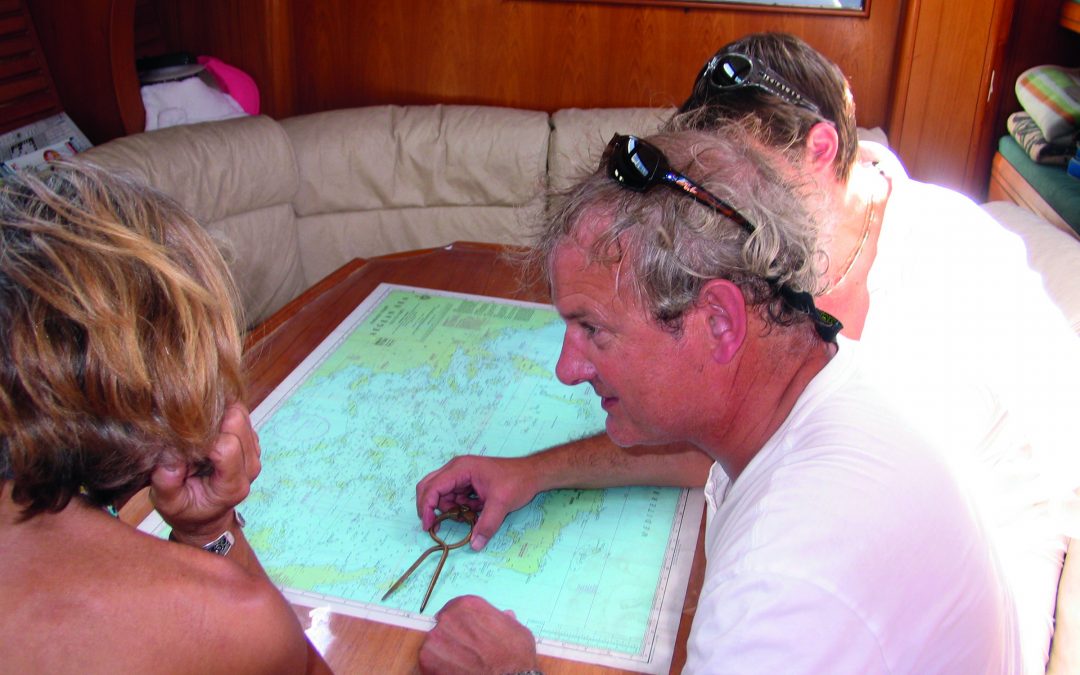Yachting Safety Briefing
Down below
Lifejackets and harnesses – fitting, when to wear, clipping on
Gas – risks, precautions, gas bottles and taps
Fire prevention – extinguishers, fire blanket, where and how to use
Moving around – companionway, handholds, galley safety
Heads – how to use
Seacocks – location of
Hatches – opening and closing, risks
VHF – how to use
Engine – basic operation
Batteries – location
On deck
Hazards – boom, tripping, slipping, hatches
Clipping on – jackstays
Heaving line
Engine controls
Instruments
Lockers – contents
Winches and clutches – safe operation
Anchor – safe operation
Emergency at sea
First aid – kit location
MOB – equipment – throwing line, horseshoe buoy, Dan buoy
Flares – where, when and how to use
VHF – emergency procedure
EPIRB – how to activate
Liferaft – where, when and how to launch
Grab bag – where, contents
Steering failure – emergency tiller, where and how
Flooding – seacock failure, plugs. Bilge pumps. Bailing.
Crew welfare
Seasickness – what to do, how to avoid
Food and drink – use of galley
Kit – stowage
“One hand for you – the other for the boat!”
This post is an extract from the Safe Skipper App for iPhone & Android.
Antifouling for leisure boats – Part 3
Antifouling is one of the least pleasant boat maintenance jobs to do, but it has to be done. The very worst job of all is removing the old antifouling as this can get seriously messy and is very hard work.
Essential Boat Safety Briefing
Distress flares – which flare, how & when to use?
Boat maintenance log
Know your Navlights & Shapes – essential for all skippers
2023 Rolex Fastnet Race – Part 3
This is our third and final article about the 2023 Rolex Fastnet Race. It is a first hand account by Simon Jollands who was one of the crew of Lancelot II, a Beneteau First 40 skippered by John Gillard.
Jester Challenge 2022 – Sailing single handed from Plymouth UK to the Azores: Part 5 – Boat Management
Jester Challenge – A modern experiment in old-fashioned self-reliance, self sufficiency, and personal responsibility. This is the fifth of a 10-part post where solo sailor, Bernie Branfield, shares his first hand account of his single-handed, 2022 Jester Challenge, from Plymouth, UK to the Azores, in his 26′ Invicta Mk2, Louisa.
Fixing position at sea using traditional methods
This post looks at some traditional methods used for fixing a vessel’s position at sea, within sight of land. Electronic fixes using chart plotters are very straightforward to record, but if for some reason a vessel’s electronics are faulty it is essential that a skipper knows how to use traditional methods.
Keel maintenance and Repair – Part 2
If you have ever witnessed a boat colliding with a rock or other submerged obstacle you will know that there is an almighty thump and the whole boat shakes and judders. While such hard groundings seldom result in catastrophic keel failure, something has to give and even the sturdiest keels can easily be damaged by such an impact.
Boat engine basics
Jester Challenge 2022 – Sailing single handed from Plymouth UK to the Azores: Part 4 – Navigation
Jester Challenge – A modern experiment in old-fashioned self-reliance, self sufficiency, and personal responsibility. This is the fourth of a 10-part post where solo sailor, Bernie Branfield, shares his first hand account of his single-handed, 2022 Jester Challenge, from Plymouth, UK to the Azores, in his 26′ Invicta Mk2, Louisa.
Antifouling for leisure boats – Part 4
Applying antifouling. Antifouling is best applied on a dry, calm day. It is best to apply the antifouling in the middle of the day to ensure the hull is dry and as warm as possible.
Marine engine oil system maintenance
The regular maintenance of a marine diesel is key to preventing engine failure at sea. This means doing regular checks of the fuel, cooling, electrical and oil systems.
Rudders and steering systems – Part 2
One thing all rudders have in common is that they have three main parts that need to be checked: the rudder, or a steerable drive leg in the case of many power boats; the system that joins the rudder to the steering; the steering control itself.
Seized fixings and fastenings
Maintaining a boat can be a rewarding experience but at times it can also be frustrating. A prime example of this is when you come across a seized fixing or fastening that refuses to budge. Read our tips on how to release and fix them:
Avoiding personal dangers at sea
In order to stay safe at sea, we need to know the risks we are facing and to be aware of any personal dangers we could possibly encounter. Here are six of the most common potential dangers individual crew members should be aware of.
Safety Briefings – leave nothing to chance
Estimating your position at sea
Navigators use a combination of techniques to estimate their position at sea. The primary method used today is GPS (Global Positioning System), a network of 24 satellites that became fully operational in the 1990s and was originally restricted for use by the United States military.
Safe Skipper – crew management tips
Effective crew briefings are a vital part of the good on-board communication that helps everything to run smoothly on a sailing vessel at sea, whether it is cruising or racing.
Essential Knots: Sheet bend
Boatyard Health and Safety
Jester Challenge 2022 – Sailing single handed from Plymouth UK to the Azores: Part 2 – Weather
Jester Challenge – A modern experiment in old-fashioned self-reliance, self sufficiency, and personal responsibility. This is the second of a 10-part post where solo sailor, Bernie Branfield, shares his first hand account of his single-handed, 2022 Jester Challenge, from Plymouth, UK to the Azores, in his 26′ Invicta Mk2, Louisa.









